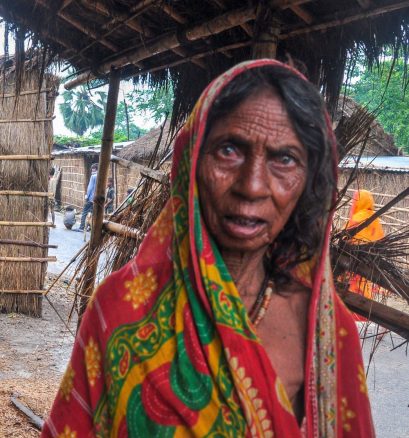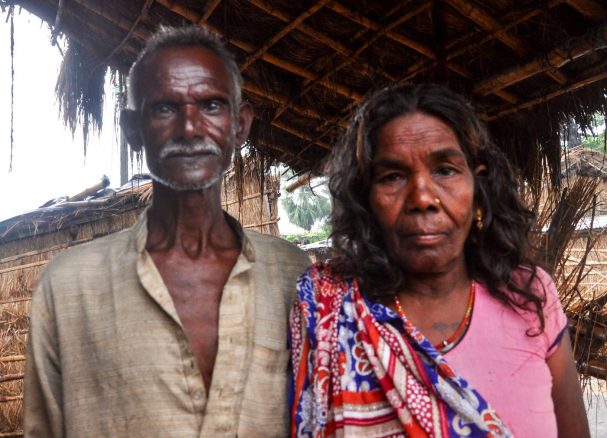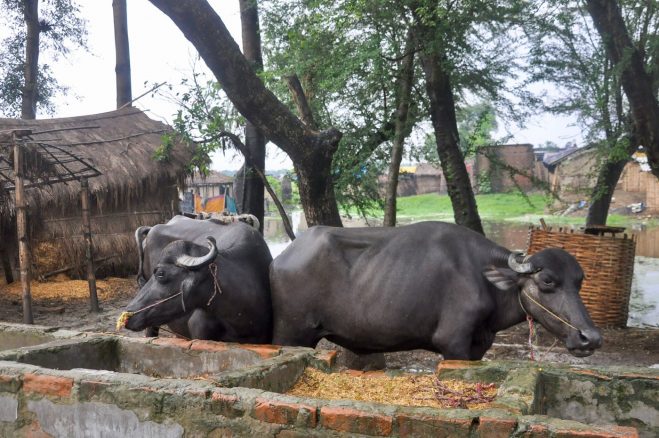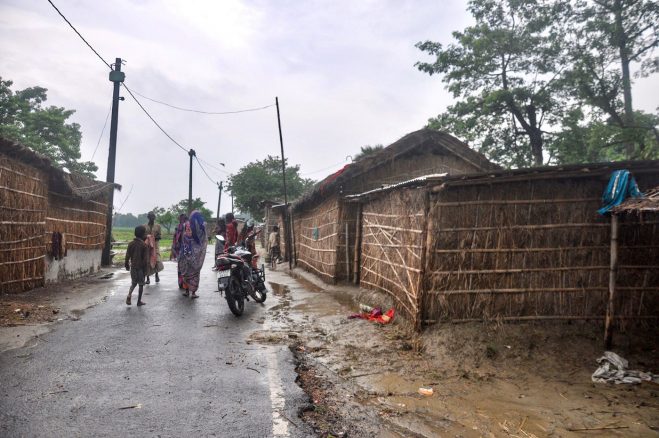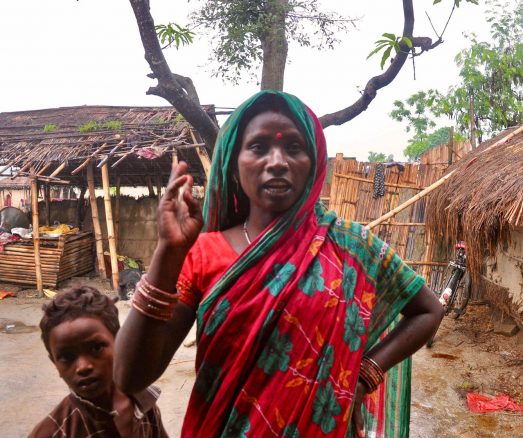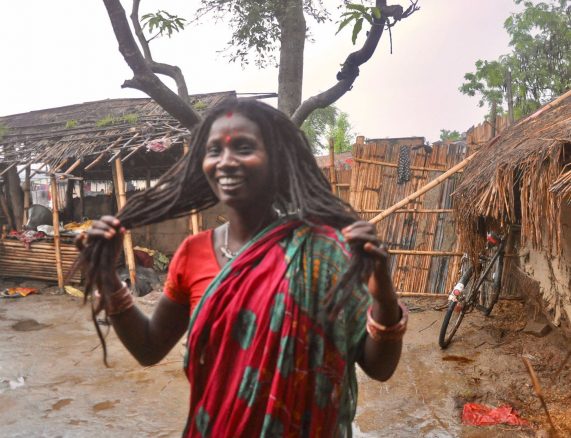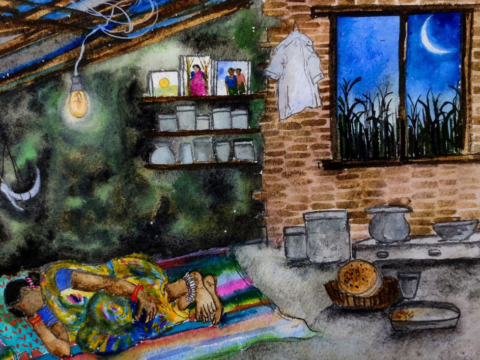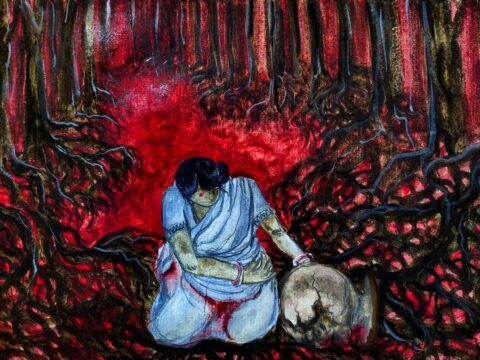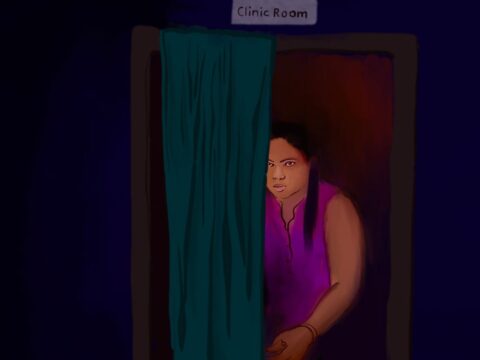
Shanti Manjhi has given birth to seven kids at home in her Musahar hamlet in Bihar’s Sheohar district. Few here have access to health services and most don’t know if there is a PHC that helps with deliveries.
Shanti Manjhi was 36 years old when she became a grandmother for the first time in January this year. That night, she notched up one more first — the wiry woman who has given birth to seven children in a span of two decades, all in the privacy of her home with no doctor or nurse in attendance, finally visited a hospital.
“My daughter was in pain for hours but the baby didn’t come out. We had to call a tempo,” she says, recounting the day when her eldest daughter, Mamta, went into labour at home. By ‘tempo’ she means a three-wheeler passenger vehicle that took nearly an hour to arrive around sunset from Sheohar town, just four kilometres away. Mamta was rushed to the district hospital in Sheohar, where she delivered a baby boy several hours later.
“He charged Rs. 800,” Shanti grumbles, still outraged about the tempo fare. “Nobody in our tola goes to the hospital, so we don’t know if there’s an ambulance.”
Shanti had to return home later that night to make sure her youngest child, four-year-old Kajal, had eaten something before bedtime. “I’ve become a grandmother,” she says, “but I have a mother’s responsibilities too.” Besides Mamta and Kajal, she has three more daughters and two sons.
The Manjhi family lives in Musahar Tola, a cluster of huts located about a kilometre outside Madhopur Anant village in north Bihar’s Sheohar block and district. The roughly 40 mud and bamboo huts in the tola are home to about 300-400 people. All of them belong to the Musahar caste, designated as a Mahadalit community – among Bihar’s most marginalised. In a partitioned corner of some of the cramped interiors, a few goats or a cow are tethered.

Shanti with four of her seven children (Amrita, Sayali, Sajan and Arvind): all, she says, were delivered at home with no fuss
Shanti has just fetched a red plastic bucket of water from the common hand pump at one end of the tola. It’s around 9 a.m., and she’s standing on the narrow road outside her home, where a neighbour’s buffalo is lapping water from a trough cemented into the roadside. She says, speaking in a local dialect, that she had no trouble with her own deliveries, “ saat go ” or seven of them, all conducted at home with minimum fuss.
“ Meri deyadin,” she shrugs when asked who cut the umbilical cord. The deyadin is the wife of the husband’s brother. What was used to cut the cord? She shakes her head, she doesn’t know. Around 10-12 women of the hamlet gathered around to say a household knife is washed and used — it’s not something anybody seems to give any thought to.
Most of the women in this Musahar tola of Madhopur Anant have similarly given birth in their own huts – though some, they say, were taken to the hospital due to complications. There is no expert birth attendant in the hamlet. Most of the women have at least four or five children, and nobody knows whether there is a primary health centre (PHC) in the village or if deliveries are conducted there.
“I am not sure,” says Shanti, when asked if their village has a health centre or state-run dispensary. Bhagulania Devi, 68, says she has heard of a new clinic in Madhopur Anant, “but I have never been there. I don’t know if they have a lady doctor.” Shanti Chulai Manjhi, 70, says nobody has ever informed the women of her tola so “if there is a new clinic, how would we know?”
Madhopur Anant does not have a PHC, but it has a sub-centre. The villagers say it remains closed most of the time, as it is on the afternoon of our visit. The 2011-12 District Health Action Plan states that Sheohar block requires 24 sub-centres – it had 10.
Shanti says she didn’t receive any iron or calcium supplements from the anganwadi during any of her pregnancies, nor did her daughter get these. And she did not go anywhere for any check-ups.
She also worked right through each of her pregnancies, until the very day of the delivery. “After 10 days, I was back at work,” she says, after each childbirth.
Dhogari Devi (left), says she has never received a widow’s pension. Bhagulania Devi (right, with her husband Joginder Sah), says she receives Rs. 400 in her account every month, though she is not sure why
Under the government’s Integrated Child Development Services (ICDS) scheme, pregnant or lactating women, as well as infants, are entitled to nutrition supplements either in the form of a grocery package or hot, cooked meals served in the anganwadi . Pregnant women are to be supplied iron-folic acid tablets and calcium supplements for a minimum of 180 days during the pregnancy. Though she has seven children and now a grandson, Shanti says she has never heard of such a scheme.
In next-door Mali Pokhar Bhinda village, the Accredited Social Health Activist (ASHA) Kalavati Devi says the women of the Musahar Tola have not registered themselves at any anganwadi . “There are two anganwadis for this region, one in Mali Pokhar Bhinda and one in Khairwa Darap, the panchayat village. The women don’t know which they should register at, and they end up not registering at either.” Both villages are located about 2.5 km from the Musahar Tola. For Shanti and the other women, all from landless households, that is a rather long walk in addition to the 4-5 kilometres they walk every day to work in the fields or brick kilns.
The women gathered around Shanti on the road all say they received neither the supplements nor any information about their right to claim these at the anganwadi.
The older women complain that it’s also nearly impossible for them to access other state-mandated facilities. Dhogari Devi, 71, says she has never received a widow’s pension. Bhagulania Devi, who is not a widow, says she receives Rs. 400 in her account every month, though she is not sure what subsidy this is.
Kalavati, the ASHA worker, blames the women for the confusion over their entitlements during and after their pregnancies, and their lack of education. “Everybody has five, six, seven children. The children are running around all day. I’ve told them so many times to register at the Khairwa Darap anganwadi, but they won’t listen,” she says.
What was used to cut the cord? Around 10-12 women of the hamlet gathered around say a household knife is washed and used — it’s not something anybody seems to give any thought to.
A government primary school for Madhopur Anant is located close to the tola, but barely a handful of children from the Musahar community attend. Shanti is entirely illiterate, as is her husband and their seven children. “Anyway they’ll have to work for daily wages,” says Dhogari Devi, the senior citizen.
Bihar’s Scheduled Castes have very low literacy rates. At 28.5 percent it was just about half of the all-India literacy rate of 54.7 percent among Scheduled Castes (as noted in Census 2001). Among these groups, the literacy rate for Musahars was the lowest at 9 percent.
Musahar families have historically not owned agricultural assets. A Niti Aayog survey report on the social development of Scheduled Castes and Scheduled Tribes of Bihar, Jharkhand and West Bengal showed that only 10.1 percent of Bihar’s Musahars own milch cattle, the lowest among the SC groups. Only 1.4 percent of Musahar families owned a bullock, again the lowest.
Some Musahars rear pigs, a traditional occupation that has added to their being regarded by other castes as polluting, according to the Niti Aayog report. And while other Scheduled Caste households surveyed for the report owned bicycles, rickshaws, scooters, or motorcycles, the Musahar households drew a complete blank on any ownership of vehicles.
Shanti’s family does not rear pigs. And though they have a few goats and some poultry, these are not sold — they use the milk and eggs in their own meals. “We have always worked for a living. We worked many years in other parts of Bihar and in other states too,” she says, referring to her husband and their children, who used to pitch in too when the couple laboured at brick kilns across the state.
A shared drinking water trough (left) along the roadside constructed with panchayat funds for the few cattle in Musahar Tola (right)
“We would live there for months, sometimes six months at a stretch. Once we stayed for nearly a year in Kashmir, working at a brick kiln,” Shanti says. She was pregnant at the time, though she can’t remember which son or daughter she was carrying then. “It was about six years ago.” She doesn’t know which part of Kashmir either, just that it was a large brick kiln where all the labourers were from Bihar.
The wages were better there than the rate of Rs. 450 in Bihar – Rs. 600-Rs. 650 for every 1,000 bricks, and with her kids working at the kiln too, Shanti and her husband easily made more bricks than that in a day, though she cannot recall how much they earned in total that year. “But we just wanted to be back home,” she recalls, “even for less money.”
At present, her husband, Dorik Manji, 38, is working as an agricultural labourer in Punjab, sending home between Rs. 4,000 and Rs. 5,000 a month. The pandemic and lockdowns have meant less work is available, and the labour contractor prefers to hire only men right now, Shanti says, explaining why she’s working here on paddy fields. “But payments are a problem. The owner waits to select a day for payments,” she says, complaining that she has to return to the same farmer’s home multiple times to ask for her banihari or wages. “But at least we’re at home,” she adds.
Her daughter Kajal is playing by the roadside at dawn on a rainy day, along with other children of the hamlet, all drenched. Shanti tells her to put on a frock, one of two nice ones she owns, for our photos. Soon after, the child is back by the slushy road, frock discarded, among a group of kids chasing a rounded stone with sticks.
Sheohar is Bihar’s smallest district in geographical size and population, carved out of Sitamarhi in 1994. The district headquarters of Sheohar is its only town. As the Bagmati, the district’s major river and an important tributary of the Ganga swell with rainwater rushing down from its source in Nepal, villages get inundated several times during the monsoon, in tandem with flooding all across northern Bihar as the Kosi and other river systems run close to their danger marks. Paddy and sugarcane are popular in the region, both water guzzler crops.
In Musahar Tola-Madhopur Anant, the people work on local paddy fields, and at construction sites and brick kilns in distant places. Some have relatives who own tiny parcels of land, one or two katthas (a fraction of an acre), but nobody here owns the land.
Shanti laughs when I ask if her daughter will also have as many children: ‘I don’t know that…’
Shanti’s hair, matted into dreadlocks, stands out against her dazzling smile. But when she’s asked about it, a couple of other women tug their saree pallus down to show their dreadlocks too. “It’s for Aghori Shiva,” Shanti says, but adds that it’s not meant to be tonsured as an offering. “It just became like that on its own,” she claims, “overnight.”
Kalavati is incredulous and says the women of Musahar Tola simply do not care enough for personal hygiene. ASHAs like her are entitled to receive Rs. 600 as an incentive for every institutionalised delivery, but during the pandemic period that money has been paid only partially, Kalavati says. “It’s so difficult to convince people to go to the hospital, and then the money also doesn’t come,” she adds.
The general view among non-Musahars that “these people” are stubbornly set in their ways has perhaps made Shanti extra cautious when she speaks to me about the community’s customs and practices. She doesn’t like to talk about nutrition. “We don’t eat rodents,” she says only when I specifically ask her about a prevalent stereotyped view of the Musahars.
Kalavati agrees – in this Musahar Tola, meals are usually rice and potatoes. “Nobody eats green vegetables, that’s for sure though,” says Kalavati, adding that anaemia is widely prevalent among the women and children in the hamlet.
Shanti gets subsidised rice and wheat from the fair price shop in the village (the Public Distribution System outlet), about 27 kilos in total every month. “All the children are not added in the ration card, so we can’t get the younger ones’ quota of grain,” she says. Today’s meal is rice and potatoes and moong dal, she says. There will be rotis at night. Eggs, milk and green vegetables are rare in the household, and fruits are even more so.
She laughs when I ask if her daughter will also have as many children. Mamta’s marital family is just across the border, in Nepal. “I don’t know that, but if she needs a hospital, she’ll probably come here.”
PARI and CounterMedia Trust’s nationwide reporting project on adolescent girls and young women in rural India is part of a Population Foundation of India-supported initiative to explore the situation of these vital yet marginalised groups, through the voices and lived experience of ordinary people.
Want to republish this article? Please write to zahra@ruralindiaonline.org with a cc to namita@ruralindiaonline.org

